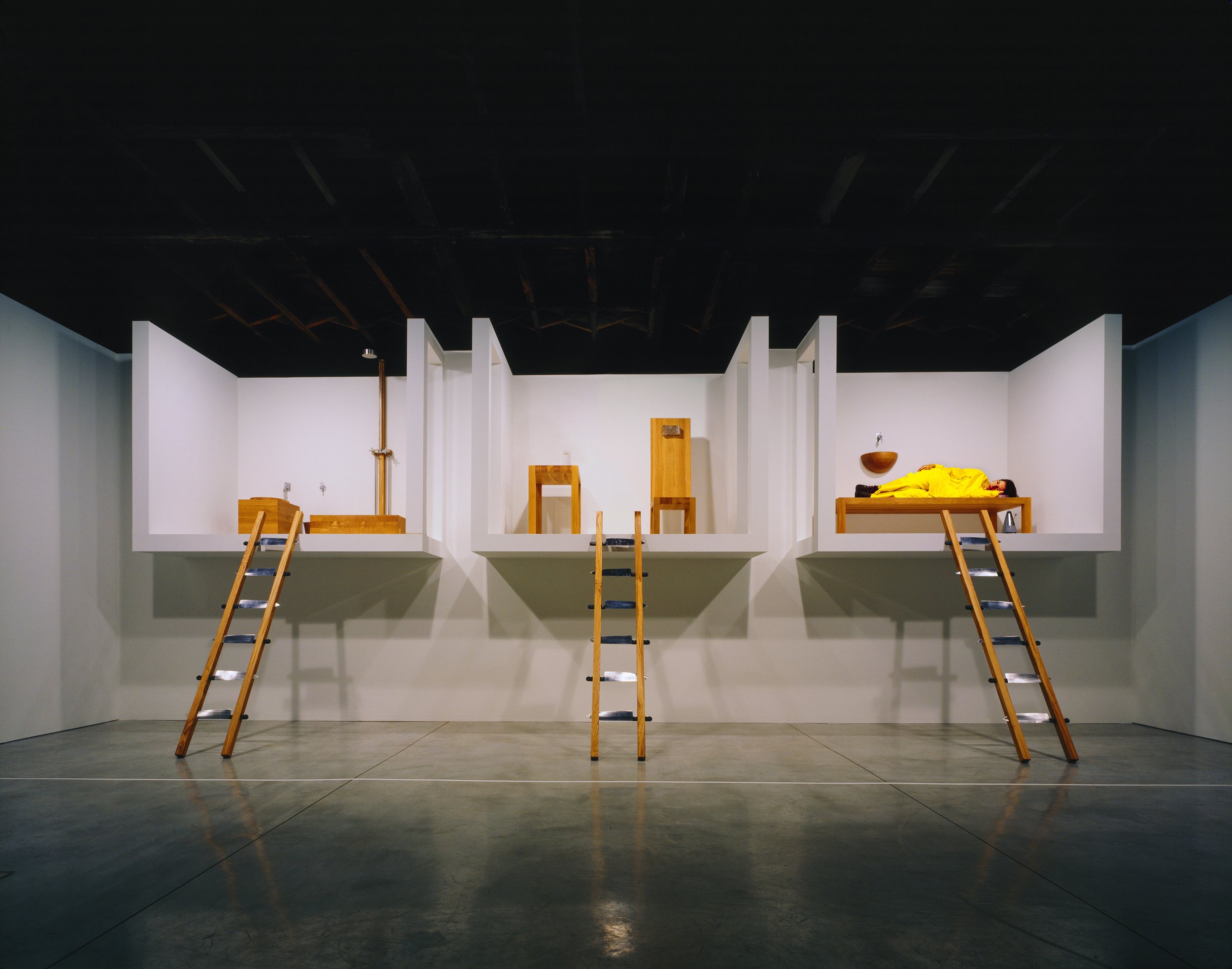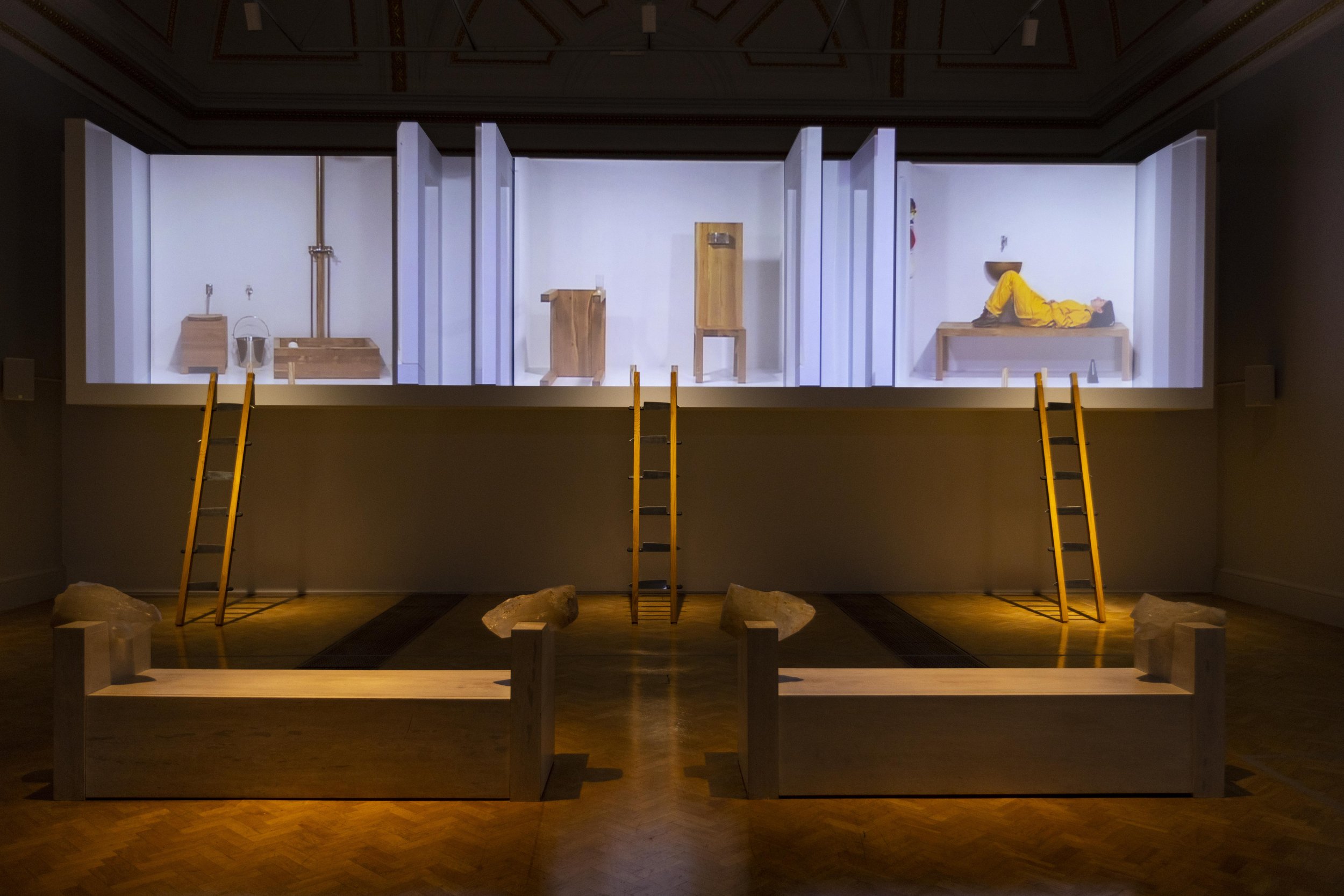On 21st November I will re-perform one of three iterations of The House with the Ocean View, a continuous 12 day performance as part of Marina Abramovic exhibition at Royal Academy of Arts, London. The other two artists are Elke Luyten and Amanda Coogan.
Marina Abramović, The House with the Ocean View, 2002. Performance; 12 days. Sean Kelly Gallery, New York. Courtesy of the Marina Abramović Archives © Marina Abramović. Photo: Attilio Maranzano
The first time I encountered Marina Abramovic’s work was in 1995 in her solo exhibition Objects, Performance, Video, Sound at the Modern Museum of Art Oxford. One part of the exhibition was a series of single images from performances with the scores of the works. Another part was the sculptural works with minerals with which one could bring one's body and being into direct contact via chairs, tables and other structures, some embedded into the walls, so as to sit, rest, stand - and feel. I remember the sense of how the works were like energetic circuits which were completed in as many ways as there were people attending the exhibition.
It was explosively powerful in its resonance with me and yet undefined.At the time I was a student in my late 20s on a foundation course in Bristol, I hadn’t studied anything much of performance, but I had thought and could feel the palpable energy of the exhibition in my body, and perhaps even more crucially - how it made me feel - the sensations.
I remember a very dear friend of mine at the time saying ‘ perhaps one day you will make work like this too’. This possibility seems to be beyond the limits of my horizon and yet, tantalisinly did not set over the cusp but hovered.
On anticipating what it is to step up and to enter The House with the Ocean View, that resonance and electric pull resurfaces.
Early in my own work the question of the viewer, the audience, the other people in the room became an immediate and pressing factor in what the work is. That those present are what completes the work. There is a reciprocity contained within performance art through the another’s being there.
Much of my early works were concerned with what it is to watch, to gaze, to look, and how might the mechanics of a gaze become visible. When we watch, what is it that happens to us that allows us to find our place within the work. How does this become a vital contribution of reciprocity?
The first works were preoccupied with the power inherent in that looking, but quickly this dissolved into a tender mode - one far less prescriptive and more open towards each person's own individual beingness - and the unknowingness of that.
When I contemplate The House with the Ocean View, my thoughts turn to the audience, the individuals who will give their time, be it fleetingly or longer periods suggest themselves, as smudges, imaginings and wonderings. I imagine the people who will come in during the gallery opening hours, I imagine as well the people who populate the gallery during closing time - the cleaners - what might we exchange? The security people - how might we regard one another as part of the work. The people tending to the exhibition and its production as well, who are not not audience.
Then there is the emptiness, being with the absence of, the silence of, the fullness of nothing. I wonder if the Royal Academy is haunted by long dead Academicians,
The emptiness of when no one is there.
The structure is like a score, its architecture, its restraints and potential jeopardies and its space, its openness. It articulates both form - and emptiness.
In the Buddhist traditions that come from the Himalayan regions, the word for what we call retreat is ‘tsam’ which means parameter or boundary. A specific period of tsam will have its own particular parameters, dictates and conditions; scheduled periods of practice, perhaps when one rises and goes to sleep, whether one has periods of seeing others - or not. Time and place is structured and scheduled. Generally this is so as to accomplish something, to have a focused period of practice and activity in order to support completion of a practice, a task, or to intensify our practice with the benefit of extended and uninterrupted time - duration.
Perhaps, like many performance art works that allow for time, The House with the Ocean View could in some ways be considered in this way.
There is a wonderful quoting of Seamus Heaney in a recent article by Fintan O’Toole in the Irish Times, in it Heaney is talking about Ireland, a cultural reality of continuity, of history. Heaney writes about inheritance as legalese, preferring instead the expression, ‘handed down’, which ‘presupposes the physical handover of a gift; it situates the exchange in a social context, implies a kind of handshake.’ Being invited to perform The House with the Ocean View brings with it the invitation of entering into the possibility of realising what Marina realised, the transformative potentials inherent within the work. It also suggests passing something on in the tangible and very physical reality of the work.
In the Trans-Himalyan traditions of Buddhism there is the principle of transmission, there are different categories such as formal, informal, symbolic, non-symbolic but what is constant is a principle of continuity from one who has realised - the teacher, to one who is receptive, the student. A method of practice is taught or transmitted to the student by the teacher, the teacher being the one who has accomplished and mastered the practice. The student receives within the transmission the potential for its full and unrestrained flowering. Traditionally the student would then enter a period of retreat to practice the method and to and realise it for themselves. Transmission implies lineage, continuity, integrity and liveliness. What we might call legacy flourishes into the present as actual, real and vital rather than ossified, brittle information.
Elke, Amanda and I have all worked with Marina before, and with each other. It’s an extraordinary honour to be trusted with this work, it’s challenges, and the revealings and transformations that can only be discovered through entering the work. The empty space that Marina offers us to inhabit and to discover is also one of difference, acute and generative difference as Elke, Amanda and I are three entirely other bodies in three entirely other times and space. There is a method, and yet, given our differences, experiences will, have many variations and alterities.
In the foreword to the monograph Kira O’Reilly (Untitled) Bodies Marina wrote:
In the 1970’s performance was such an important art form. But then by the end of the decade performance artists just gave up. It was too difficult. It was too energy-consuming and we didn’t have any kind of privacy. So for somebody like Kira O’Reilly who’s been doing this for almost 20 years for he she’s a warrior. You can’t deal with this art form if you don’t have true commitment and purpose. Without this, this art form is not possible.
Gallery view of the Marina Abramović exhibition at the Royal Academy of Arts, London, from 23 September 2023 – 1 January 2024, showing The House with the Ocean View, 2002/2023.
Courtesy of the Marina Abramović Archives. © Marina Abramović. Photo © Royal Academy of Arts, London / David Parry


